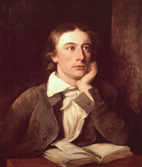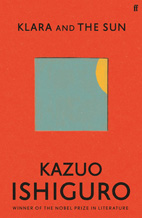Initially, there might not seem to be a great deal of common ground between the archetypal young Romantic poet, John Keats, an one of our pre-eminent contemporary novelists, Kazuo Ishiguro. However, they have both cropped up in articles over the last couple of weeks and it is clear that both use their works to question the position of humanity in the world and the direction which human beings are taking, or are contemplating taking. Their precise concerns are slightly different because of the times in which they are writing, but the core principles are similar.
 Sweeping Romantic poetry, the untimely death of his brother, unrequited love and death in Rome of consumption at the age of 25 make Keats the poster boy of Romanticism and his influence is striking. Those studying the Poems of the Decade will find that Tim Turnbull’s ‘Ode on a Grayson Perry Urn’ is a clever contemporary pastiche of Keats’ ‘Ode on a Grecian Urn’ and the Romantic poem’s consideration of the role of art. The Keatsian echoes are distinctly present too in Jo Shapcott’s ‘At Guy’s Hospital’ which might be a comparison piece to some of the Decade poems. Shapcott implicitly refers to ‘Ode to a Nightingale’ and is concerned with similar ideas of mortality and the solace of “Old Nature”. The current Poet Laureate, Simon Armitage, has written his own poetic tribute to his “hero”, John Keats.
Sweeping Romantic poetry, the untimely death of his brother, unrequited love and death in Rome of consumption at the age of 25 make Keats the poster boy of Romanticism and his influence is striking. Those studying the Poems of the Decade will find that Tim Turnbull’s ‘Ode on a Grayson Perry Urn’ is a clever contemporary pastiche of Keats’ ‘Ode on a Grecian Urn’ and the Romantic poem’s consideration of the role of art. The Keatsian echoes are distinctly present too in Jo Shapcott’s ‘At Guy’s Hospital’ which might be a comparison piece to some of the Decade poems. Shapcott implicitly refers to ‘Ode to a Nightingale’ and is concerned with similar ideas of mortality and the solace of “Old Nature”. The current Poet Laureate, Simon Armitage, has written his own poetic tribute to his “hero”, John Keats.
It was interesting to see, then, 200 years after Keats’ death, a number of poets selecting their favourite Keats poem. Poets, as you would expect, have a particular eye and ear, picking out the key aspects which for them are influential in the poems. This is a great article to introduce you to Keats if you have not read his poetry before, as it contains some Keats classics as well as a couple of more unusual choices.
If you want to know a bit more about Keats in a way which undercuts the pieties, I recommend reading Anthony Burgess’ novel ABBA ABBA, which deals with Keats’ last days in Rome. It’s amusing, forthright and moving. There’s an article on it here.
 So where does Kazuo Ishiguro (Nobel Prize for Literature 2017) fit in? His novels have always explored how human beings react to their circumstances and events, so the historical context is central to novels like An Artist of the Floating World (1986) and perhaps his most famous work, The Remains of the Day (1989). Some of his more recent work has extended that range, by exploring ancient post-Arthurian history and myth in The Buried Giant (2015) and in the speculative fiction of a world just like ours, but where clones are created for the harvesting organs in Never Let Me Go (2005). He has just published his latest novel, Klara and the Sun, again speculative fiction, exploring the implications of AI on humanity. The key thing about Ishiguro is that he also writes with humanity – always.
So where does Kazuo Ishiguro (Nobel Prize for Literature 2017) fit in? His novels have always explored how human beings react to their circumstances and events, so the historical context is central to novels like An Artist of the Floating World (1986) and perhaps his most famous work, The Remains of the Day (1989). Some of his more recent work has extended that range, by exploring ancient post-Arthurian history and myth in The Buried Giant (2015) and in the speculative fiction of a world just like ours, but where clones are created for the harvesting organs in Never Let Me Go (2005). He has just published his latest novel, Klara and the Sun, again speculative fiction, exploring the implications of AI on humanity. The key thing about Ishiguro is that he also writes with humanity – always.
There’s a fascinating interview with him here.
And here you will find an early review of the latest novel.